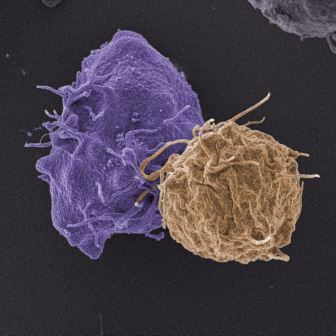 New research carried out by scientists at the UCL Institute of Immunity and Transplantation (IIT) has found that HIV spreads in a similar way to some computer worms.
New research carried out by scientists at the UCL Institute of Immunity and Transplantation (IIT) has found that HIV spreads in a similar way to some computer worms.
The research also suggests that treating patients early is the key to staving off AIDS.
HIV experts at the IIT, based at the Royal Free Hospital, discovered that the virus spreads through the body using two methods – via the bloodstream and directly between cells. And it was noticed that this was similar to how some computer worms spread through both the internet and local networks to infect as many computers as possible.
The scientists joined forces with computer security experts at University College London and created a model for this ‘hybrid spreading’ which accurately predicted patients’ progression from HIV to AIDS during a clinical trial.
HIV destroys particular immune cells, known as T-cells, and over time this means the immune system cannot function properly, leading to AIDS.
Current World Health Organisation guidelines, which doctors in the UK follow, recommend beginning HIV treatment only when the number of T-cells in the bloodstream falls below a certain level. However, the new model predicts that treatment should start as soon as possible after infection with HIV to prevent AIDS from developing further down the line.
Professor Benny Chain, who jointly led the research, said: “The number of HIV cells in the bloodstream is always relatively low, and our model shows that if HIV spread through the bloodstream alone it would not be enough to cause AIDS.
“It is likely that when HIV gains a foothold somewhere with a high T-cell population, such as the gut, it uses a cell-to-cell transfer mechanism to efficiently spread directly between the T-cells. Current drugs are more effective at stopping the infection spreading through the bloodstream than they are stopping cell-to-cell transfer.
“Our model suggests that the new treatments which are currently being developed to achieve a permanent HIV cure, rather than simply suppressing the growth of virus, will need to be administered as early as possible to have any reasonable chance of success.
“In addition, this research highlights the need to develop new drugs, which are better at preventing cell-to-cell transfer of HIV. A drug that could completely block the virus spreading in this way would prevent HIV progressing to AIDS.”
The model was inspired by similarities between HIV and computer worms such as the highly damaging ‘Conficker’ worm, first detected in 2008, which has infected military and police computer networks across Europe and is still active today.
Changwang Zhang, computer scientist at UCL and the co-author of the research paper, said: “HIV and Conficker have a lot in common. They both use hybrid spreading mechanisms, persist for a very long time and are incredibly difficult to eradicate. Our model enables us to explain these important properties and to predict the infection process.”
Laboratory research led by Dr Clare Jolly has previously shown that some drugs are better than others at stopping HIV from spreading directly between cells. However, it is not possible to directly measure cell-to-cell spread in patients because it takes place inside internal organs.
“With this new model, we should be able to assess the effectiveness of drugs against different modes of HIV spread in real patients,” explained Dr Jolly. “This could prove invaluable when interpreting the results of drug trials to understand what works and why.
“Using computer models to understand processes that we cannot directly observe is common in the physical sciences and supports many fundamental theories. Our model provides strong evidence that cell-to-cell spread is an important part of HIV spread, and we hope to show this directly in future animal studies.”
 Translate
Translate